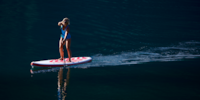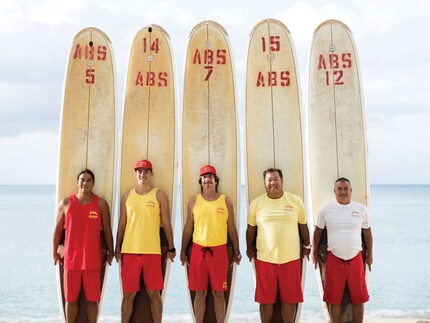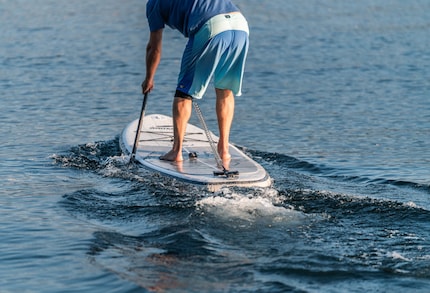
Guide
Stand-up paddleboards 101
by Siri Schubert

By winning the America's Cup in 2003, Ernesto Bertarelli and his sailing team «Alinghi» taught us one thing: Switzerland is a water sports nation. All joking aside – a lake or a river combined with the right SUP board and a paddle and off you go. Who needs an ocean anyway?
With origins in Hawaii, stand up paddling became popular with tourists visiting the Pacific islands in the economic upswing after the Second World War. Hotel at the famous Waikiki Beach used to rent out surfboards to their guests. Local surfers, so-called «beach boys», would accompany tourists on their surfing experience and capture every moment on camera.
At that time, cameras were massive and expensive. The «beach boys» would have a hard time trying to take good pictures and not damaging the camera while lying down on their surfboard. So at some point, they began to stand up, paddle along the tourists with the camera around their neck, making it easier to take pictures. And that’s how stand up paddle boarding was invented.
What began in Hawaii in the 1950s has since developed into a trend sport. Whichever Swiss lake or river you’re on, you’re sure to see stand up paddle boarders. Would you like to give SUPing a go this summer?
If you’d like to take valuables or other items with you when you’re standing up paddle boarding, store them in a waterproof SUP backpack or a dry bag.
You're still reading? Great. I assume you’re not a SUP pro and are looking for an entry-level model. Your best choice: an allround or touring board.
While touring boards allow you to go faster, allround models are suitable for beginners and universal use. Touring boards are long and have a sharp nose to better cut through the water, making them ideal for lakes and slow-flowing rivers.
Allrounder boards great for beginners and – as their name suggests – are extremely versatile and cope with everything from flat water, cruising, to surfing. These boards have a wider, bulkier hull and often three fins, making them very stable and easy to manoeuvre. They have a wider and often rounded tail, sometimes slightly cut off. The soft edges and rounded shape give all-rounder boards very balanced characteristics, which is ideal for SUP boarding beginners.
Do you need a hardboard or an inflatable SUP? This question is key. My advice is to keep an open mind and let the facts speak for themselves before making a decision. There are advantages and disadvantages with both types, as well as also large differences in quality and features within both types. Take all these facts into account when making a decision.
Hardboards
The «GLIDE Bamboo» by Oxbow is an all-round hardboard.
Go to all allround hardboards on Galaxus
Indiana’s model, named «Touring», nomen est omen, is our bestselling touring SUP board.
View our full range of touring boards
The model «Heavy Duty» by Indiana is also suitable for fitness exercises and yoga.
The «Tracer x29» by Bic is a race board.
The choice of materials is a discipline in itself. Whether epoxy, plastic, veneer, wood or carbon, in the end your budget will influence your decision. The differences in quality are not quite as great as with inflatable boards. But if you are looking for a board that' as light, beautiful, rigid and fast as possible, you'll have to invest a lot of money.
Indiana designed the «Stubby Wave» specially to perform well in waves.
Go to all boards designed for waves
«Wood Kids» is the entry-level board for kids by Indiana.
Inflatable boards
Inflatable SUP boards are a main reason why this trend sport is growing so fast. Folded up, they take up hardly any storage space and are easy to transport. Whether you're travelling by public transport, on foot, in a small car or by bike, you're able to take an inflatable SUP board anywhere.
Pumped up to a pressure of about one bar, good inflatables are easy to manoeuvre. They feel like a real board. The inside of inflatable boards is lined with so-called drop stitch threads that connect the upper and lower deck. The more air you pump into it, the more tension you put on the threads, making the board rigid.
The «Union» by Guruu is an affordable all-round board, which is inflatable and ideal for beginners.
See our full range of inflatable allround boards
My office neighbour Michael Restin, who tested this board last summer, shares my opinion:
The «Family Pack» by Indiana is the test winner of Swiss consumer magazine «Kassensturz». It’s ideal for touring.
Go to all inflatable touring boards
An advantage of inflatable boards that's often underestimated is how sturdy they are when it comes to touching stones. While you have to be very careful with hardboards when you get close to the shore or are in shallow water, inflatable SUP boards aren’t as sensitive. On top of this, passengers such as children or dogs have better grip and comfort when they’re sitting on an inflatable board than on a hardboard. This is also ideal for SUP yoga.
Fanatic’s inflatable «Fly Air Fit» lets you do your workout on the water. It is also suitable for yoga.
Airboard produces the «Rocket», a race board that features a unique shape.
What's great for SUP newcomers is that inflatable boards don't hurt as much if you fall or are hit. In addition, inflatable models are bit softer and more forgiving on moving water, making it easier to keep standing one your board.
However, they are more sensitive when it comes to storing them in warm rooms or leaving them out in direct sunshine. This can cause them to leak or even burst. Not protecting your board properly may reduce its durability considerably. Reinforced seams, preferably bright colours (especially on the sides) and, above all, correct storage have positive effects – whenever possible, keep your board in the shade.
The new Fanatic «Fly Air Set» is especially suitable for surfing.
View our complete range of SUP boards for surfing
Indiana’s «Kids Pack» is the ideal start into children’s stand up paddle boarding career.
Go to all inflatable boards for kids
Inflating your board is less fun than using it on the water, but a good hand pump or an electric pump makes it as easy as possible. Many boards come with a pump and a bag, but without paddle.
So do you need a hardboard or an inflatable board? If you don't intend to do this sport competitively, an inflatable board is a good choice. As mentioned, I recommend going for an all-round or touring board.
How large does you board need to be in terms of volume? The rule of thumb is: add at least 110 litres to your body weight in kilograms. If you weigh 80 kilos, you'll need a board with at least 190 litres of volume. This means, the Indiana Family Pack with 307 litres is ideal for you. The extra volume provides extra stability and means you can have passengers, your kids or your dog, for instance, on board with you.
Check out our full range of SUP boards.
From radio journalist to product tester and storyteller, jogger to gravel bike novice and fitness enthusiast with barbells and dumbbells. I'm excited to see where the journey'll take me next.
Practical solutions for everyday problems with technology, household hacks and much more.
Show all

Stand up paddle boards can be used on rivers and lakes without permission. All relevant legal information can be found here in English or here, here
and here in German.
As the name suggests, hardboards are hard, rigid and stiff. Just a «real board». The more rigid they are, the better their water position and the better they glide on the water. This means it’s natural and easy for you to manoeuvre. Another big advantage is that manufacturers can put edges and these boards and shape them. Edges on the sides provide more grip on the rails, while rounded edges increase glide and speed. The board’s nose has a narrower shape that allows it to cut through any wind chop on the water. Compared to hardboards, inflatable SUP boards are much more limited in terms of shaping.
Hardboards often have less volume than inflatable board and sit flatter and more balanced on the water. In competitions, they are unbeatable. For all other uses, there are good inflatable boards, too.
Hardboard, however, aren’t unbreakable. Watch out for stones – hit a stone and the carbon, epoxy or veneer may get damaged. What you need to do if this happens is seal the gap as quickly as possible to make sure that no water gets into your board. Water inside your board can shorten the life span of the hardboard massively.
